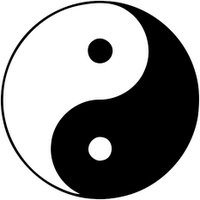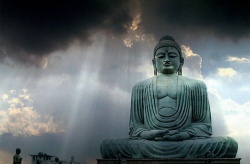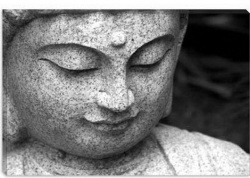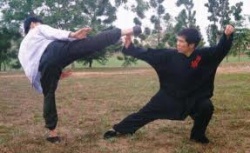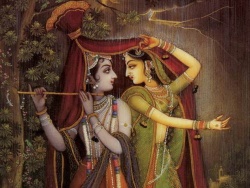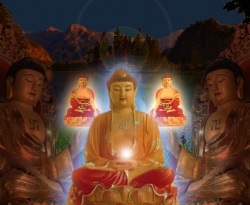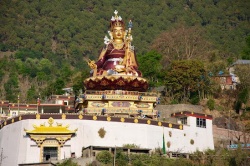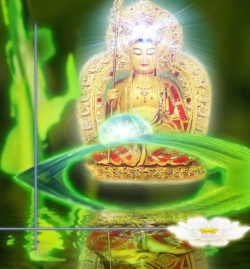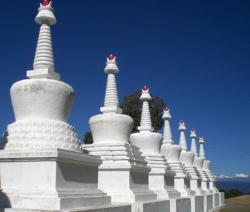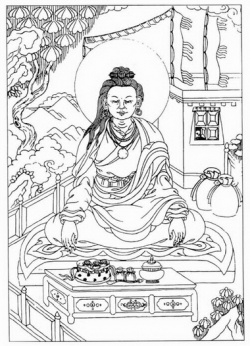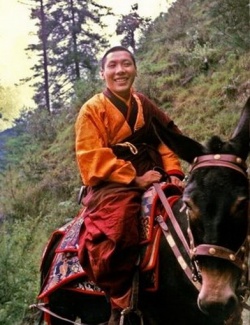Yin and yang
Click here to see other articles relating to word Yin and yang
In Chinese philosophy, the concept of yin-yang (simplified Chinese: 阴阳; traditional Chinese: 陰陽; pinyin: yīnyáng), which is often called "yin and yang", is used to describe how opposite or contrary forces are interconnected and interdependent in the natural world; and, how they give rise to each other as they interrelate to one another.
Many natural dualities (such as light and dark, high and low, hot and cold, fire and water, life and death, and so on) are thought of as physical manifestations of the yin-yang concept.
The concept lies at the origins of many branches of classical Chinese science and philosophy, as well as being a primary guideline of traditional Chinese medicine, and a central principle of different forms of Chinese martial arts and exercise, such as baguazhang, taijiquan (t'ai chi), qigong (Chi Kung), and I Ching.
Yin and yang can be thought of as complementary (instead of opposing) forces interacting to form a dynamic system in which the whole is greater than the parts.
Everything has both yin and yang aspects, (for instance shadow cannot exist without light). Either of the two major aspects may manifest more strongly in a particular object, depending on the criterion of the observation.
In Taoist metaphysics, good-bad distinctions and other dichotomous moral judgments are perceptual, not real; so, yin-yang is an indivisible whole.
In the ethics of Confucianism on the other hand, most notably in the philosophy of Dong Zhongshu, (c. 2nd century BC) a moral dimension is attached to the yin-yang idea.
The concept of yin and yang is often symbolized by various forms of the Taijitu symbol, for which it is probably best known in Western cultures.
Nature
In Daoist philosophy, dark and light, yin and yang, arrive in the Dàodéjīng (道德經) at chapter 42. It becomes sensible from an initial quiescence or emptiness (wuji, sometimes symbolized by an empty circle), and continues moving until quiescence is reached again.
For instance, dropping a stone in a calm pool of water will simultaneously raise waves and lower troughs between them, and this alternation of high and low points in the water will radiate outward until the movement dissipates and the pool is calm once more. Yin and yang thus are always opposite and equal qualities.
Further, whenever one quality reaches its peak, it will naturally begin to transform into the opposite quality:
for example, grain that reaches its full height in summer (fully yang) will produce seeds and die back in winter (fully yin) in an endless cycle.
It is impossible to talk about yin or yang without some reference to the opposite, since yin and yang are bound together as parts of a mutual whole (for example, there cannot be the bottom of the foot without the top).
A way to illustrate this idea is to postulate the notion of a race with only men or only women; this race would disappear in a single generation.
Yet, men and women together create new generations that allow the race they mutually create (and mutually come from) to survive.
The interaction of the two gives birth to things. Yin and yang transform each other: like an undertow in the ocean, every advance is complemented by a retreat, and every rise transforms into a fall.
Thus, a seed will sprout from the earth and grow upwards towards the sky—an intrinsically yang movement.
Then, when it reaches its full potential height, it will fall. Also, the growth of the top seeks light, while roots grow in darkness.
Toponymy
Many places in China, such as Luoyang, contain the word yang, and a few, such as Huayin, contain the word yin. This is a very old way to assign place names.
Classically, when used in place names, yang refers to the "sunny side."
The word 太陽 (simplified 太阳), tàiyáng, refers to the sun, and literally means "great yang."
In the northern hemisphere, sunlight comes predominantly from the south, and so the south face of a mountain (or the north face of a river valley) will get more direct sunlight.
Therefore, yang means a place is on the south slope of a mountain (or on the north bank of a river valley).
For example, Luoyang is on the north bank of the Luo River valley.
In the same way, yin would be the opposite, the "shady side." Yin means that a place is on the north slope of a mountain (or on the south bank of a river). For example, Huayin is on the north slope of Mount Hua.
Symbolism and importance
Yin is the black side with the white dot on it, and yang is the white side with the black dot on it.
The relationship between yin and yang is often described in terms of sunlight playing over a mountain and a valley. Yin (literally the 'shady place' or 'north slope') is the dark area occluded by the mountain's bulk, while yang (literally the 'sunny place' or 'south slope') is the brightly lit portion.
As the sun moves across the sky, yin and yang gradually trade places with each other, revealing what was obscured and obscuring what was revealed.
Yin is characterized as slow, soft, yielding, diffuse, cold, wet, and passive; and is associated with water, earth, the moon, femininity and nighttime.
Yang, by contrast, is fast, hard, solid, focused, hot, dry, and aggressive; and is associated with fire, sky, the sun, masculinity and daytime.
Yin and yang applies to the human body. In traditional Chinese medicine good health is directly related to the balance between yin and yang qualities within oneself. If yin and yang become unbalanced, one of the qualities is considered deficient or has vacuity.
I Ching
In the I Ching, yin and yang are represented by broken and solid lines: yin is broken (⚋) and yang is solid (⚊).
These are then combined into trigrams, which are more yang or more yin depending on the number of broken and solid lines (e.g., ☰ is heavily yang, while ☷ is heavily yin), and trigrams are combined into hexagrams (e.g. ䷕ and ䷟).
The relative positions and numbers of yin and yang lines within the trigrams determines the meaning of a trigram, and in hexagrams the upper trigram is considered yang with respect to the lower trigram, allowing complex depictions of interrelations.
Taijitu
The principle of yin and yang is represented in Taoism by the Taijitu (literally "diagram of the supreme ultimate").
The term is commonly used to mean the simple "divided circle" form, but may refer to any of several schematic diagrams representing these principles, such as the swastika, common to Hinduism, Buddhism, and Jainism. Similar symbols have also appeared in other cultures, such as in Celtic art and Roman shield markings.
Taijiquan
Taijiquan, a form of martial art, is often described as the principles of yin and yang applied to the human body and an animal body. Wu Jianquan, a famous Chinese martial arts teacher, described Taijiquan as follows:
- Various people have offered different explanations for the name Taijiquan. Some have said: – 'In terms of self-cultivation, one must train from a state of movement towards a state of stillness. Taiji comes about through the balance of yin and yang. In terms of the art of attack and defense then, in the context of the changes of full and empty, one is constantly internally latent, not outwardly expressive, as if the yin and yang of Taiji have not yet divided apart.' Others say: 'Every movement of Taijiquan is based on circles, just like the shape of a Taijitu. Therefore, it is called Taijiquan.
- — Wu Jianquan, The International Magazine of T’ai Chi Ch’uan
Source
Yin-Yang (Eum-Yang in Korean)
The early Han dynasty (207 B.C. - 9 A.D.) devoted itself to regaining the same level of central government as the previous Ch'in dynasty (221 B.C.-207 B.C.) and the Legalists had gained.
This, along with the Legalists' attempts to standardize Chinese culture and philosophy, led the Han to attempt to unify all the rival schools of Chinese thought and philosophy.
The Legalists had attempted to standardize Chinese thought by burning the books of rival schools and by making it a capital crime to speak of Confucius, Lao Tzu, or Mo Tzu. Rather than reject alternate ways of thinking, the Han attempted to fuse all the rival schools of thought into a single system.
Concepts
The concepts of Yin-Yang and five elements are thought to have developed separately in ancient times and it is not until the Han Dynasty that we find them linked together in the school they retrospectively named Yin-Yang.
Tsou Yen (305-204 B.C.), a principle thinker of this school, is credited with bringing the two concepts together, but the work attributed to him is lost.
The ancients used the concepts for magic and divination. In the early Han period they were used to develop a sophisticated cosmology.
The Five Elements are discussed in the Great Norm chapter of the Book of History but there is no comparable discussion on Yin-Yang. These concepts appear in the later texts as 'given' ideas that are then developed as ways of 'explaining' all phenomena.
Yet they are not discussed together in any of the Confucian or Taoist Classics of an early date.\
The Yin-Yang ideas of Tsou Yen were developed further by Tung Chung-Shu (179-104 B.C.) and the compilers of the appendices (wings) of the I Ching.
Tung built up a body of correspondence that related the complementary principles of Yin-Yang to all phases of creation. Yin was related to the ideas of female, moon, cold, water, earth, autumn, and winter. It is also nourishes and sustains the 'myriad things'. Yin and Yang continue to succeed each other and as each 'force' reaches its extreme it becomes the other, thus producing a never ending cycle. This constant progression was used to explain the process of growth and change in the natural world.
The appendices of the I Ching expanded and developed the Yin-Yang concept into a comprehensive cosmology.
The first two hexagrams Ch'ien (heaven) and K'un (earth) were equated with Yang and Ying respectively.
These forces then assumed a metaphysical dimension and heaven and earth, where male and female become the 'creators and sustainers' of all the other hexagrams.
The sixty-four [[Wikipedia:Hexagram (I Ching)|hexagrams]] come to represent all possible situations and changes in the universe.
The study of the [[Wikipedia:Hexagram (I Ching)|hexagrams]], and their interpretations, enabled a scholar to understand the activities of the universe, which, once expanded, reveal the endless process of universal change.
All things and all changes can be described in terms of Yin-Yang activity and this is then developed further by the concept of the five elements.
Opposites
Yin and yang represent all the opposite principles one finds in the universe.
Under yang are the principles of maleness, the sun, creation, heat, light, Heaven, dominance, etc.
Under yin are the principles of femaleness, the moon, completion, cold, darkness, material forms, submission, etc.
Each of these opposites produces the other.
Heaven creates the ideas of things under yang, the earth produces their material forms under yin, and vice versa. Creation occurs under the principle of yang.
The completion of the created thing occurs under yin, and vice versa. And so on, and so on.
This production of yin from yang and yang from yin occurs cyclically and constantly, so that no one principle continually dominates the other or determines the other.
All opposites that one experiences—health and sickness, wealth and poverty, power and submission—may be explained in reference to the temporary dominance of one principle over the other.
Since no one principle dominates eternally, that means that all conditions are subject to change into their opposites.
Two important features of the relationships between opposites:
- There is some sort of correlation between the individual components of different pairs of opposites. During the day it is light and warm, the sun is out, and people are active.
Thus, these particular components all share an essential quality—daytime, light, warmth, activity and the sun.
On the other hand there is nighttime, darkness, cold, rest, and the moon, all of which share in an essential quality that is opposite in nature to the former.
- One opposite has certain distinctive relationships with the other in any given pair. They can be seen as two alternating states of development or two aspects of a cyclical movement through time.
Day changes into night, and night into day; summer changes to winter and winter into summer; activity is followed by rest, rest supports activity, dormancy is followed by growth which is followed by decay, etc.
The cyclical nature of yin and yang, the opposing forces of change in the universe, means several things.
First, all phenomena change into their opposites in an eternal cycle of reversal.
Second, since the one principle produces the other, all phenomena have within them the seeds of their opposite state, for example, sickness has the seeds of health, health contains the seeds of sickness, wealth contains the seeds of poverty, etc.
Third, even though an opposite may not be seen to be present, since one principle produces the other, no phenomenon is completely devoid of its opposite state. One is never really healthy since health contains the principle of its opposite, sickness.
This is called "presence in absence." Once you have this principle down, the particular Chinese view as expressed in literature becomes clearer.
Interrelationships
Some points about the interrelationship between yin and yang:
- Any given frame of reference can be divided into Yin-Yang pairs (i.e. pairs of opposite factors).
The planet Earth is divided into oceans and landmasses. Life forms are mobile or immobile, warm blooded or cold-blooded.
The body can be regarded as consisting of an exterior portion of skin and skeletal muscle and an interior portion of viscera and bones.
- Yin and Yang are descriptive terms; they are not nominative. Yin-Yang terminology is used when describing the nature or characteristic tendency of one thing with reference to another. Linguistically, it often appears that these terms are used as nouns, however it should always be understood that Yin-Yang are adjectives and do not refer to any concrete or existing thing.
There is always some degree of the opposite contained in anything that exists, no matter how extreme the degree of Yin or Yang.
Taking Expansion-Contraction as an example, it is impossible for the mind to conceive of pure, 100% expansiveness without any trace of the contracting force. Whatever is conceived would simply expand to infinity, i.e. out of existence.
Similarly, pure 100% contraction without any trace of expansive force would simply contract down to zero, i.e. out of existence.
It is a condition for the existence of anything that there always must be some degree of both Yin and Yang qualities present.
- Yin is complimentary to Yang and vice versa.
There does not exist any antagonism between opposites in Nature.
They are always complimentary.
The normal, healthy, functional, durable existence of everything in Nature depends on the mutual enhancement and beneficial interaction of opposite forces. Day and night; summer and winter; work and rest; man and woman.
On one level, when there is an antagonistic relationship between opposites this leads to destruction.
However, from the larger perspective, the balance of Nature is always maintained.
- Yin nourishes and sustains and controls Yang and vice versa.
Each thing depends upon its opposite in order to exist; thus Yin 'creates' Yang and Yang 'creates' Yin. Opposites also hold each other in balance and exert mutual control.
The soil produces crops for mankind; and man cultivates the soil.
If there is insufficient care and attention by the workers to the crops, there may be less crops and more weeds. Workers produce goods and services; goods and services produce wealth.
- Everything in the physical world has an opposite. There are no absolutes in the manifest universe.
Wherever there is a 'front' there will also be a 'back'; the bigger the front, the bigger the back.
Birth is followed eventually by death; economic boom by recession; conquest of nature by pollution and degradation of resources.
There are no advantages without some disadvantages; there are no disadvantages without some advantages.
- Yin attracts Yang and Yang attracts Yin. The greater the difference, the greater the attraction.
- Yin repels Yin and Yang repels Yang. The greater the similarity the greater the repulsion.
- Yin gradually changes the into Yang and vice versa.
Spring into summer, summer into autumn, autumn into winter and winter into spring... At the extremes of Yin or Yang, there is great instability and the change from one opposite to the other is rapid and inharmonious.
The 'midlife crisis' suffered by males in our culture is an example of this.
- Normal physiological conditions (i.e. Homoeostasis) require the avoidance of extremes of Yin and Yang.
The body can only resist within a narrow range of temperature, atmospheric pressure, oxygen content of the air, etc.
One can develop tolerance to extremes only by gradually introducing them to the body, but there is still definite limitations to the body's tolerance to extreme factors (e.g. heat, cold, deprivation, etc.).
- Each Yang factor can be further subdivided into a pair of Yin-Yang factors ad infinitum. Each Yin factor may also be further subdivided in the same way. Life forms can be divided into simple and complex; complex life can be divided into warm- or cold-blooded;
warm-blooded into evolved and less evolved (in terms of adaptability and capacity for learned behavior as opposed to instinct); of the more highly evolved species,
mankind can be separated out due to the potential for an advanced civilization or culture
- Nothing should be rejected.
There are no 'bad' things.
Everything has some usefulness, depending on the appropriate conditions (i.e. time, place, dosage, type of illness etc.).
Any substance may be used as a medicine, depending on the dosage (any substance may be regarded as food, medicine, or poison, at the appropriate dosage).
Five classics
Han philosophers concentrated specifically on the Five Classics, attempting to derive from them, particularly the I Ching, or Book of Changes, the principle of the workings of the universe, or Tao.
They appended this new theory of the universe to the I Ching.
This appendix explained the metaphysical workings of the entire universe and is the origin of what is called the Yin-Yang or Five Agents school of Chinese thought.
The Yin-Yang doctrine teaches that everything is the product of two principles: "Yin," which is weak, female, and destructive and "Yang," which is strong, male, and creative.
The interaction of these two principles produces the five elements and enables change to take place within the world.
These five elements represent a dynamic process, not the 'elements' that come together to produce things. The five elements are not physical substances; they represent cyclic movements. There are two orders of the five elements:
- Overcoming, where fire is overcome by water, water by earth, earth by wood, and wood by metal, producing the series, fire, water, earth, wood, metal.
This idea was developed to cover all things, and many lists of correspondence were produced.
These lists are generally given with the elements arranged in the order of production. Here are just a few of the major correspondences, which relate to both the natural world—in the case of the seasons and directions and the human world of 'discrimination' ND in the case of tastes and emotions.
However, the important point is that things that relate to human activity and the activity of nature are woven together in these lists.
| Wood | Fire | Earth | Metal | Water | |
| Direction | East | South | Center | West | North |
| Color | Green | Red | Yellow | White | Black |
| Taste | Sour | Bitter | Sweet | Acid | Salty |
| Emotion | Anger | Joy | Pensive | Grief | Fear |
| Season | Spring | Summer | Autumn | Winter |
There are five elements and four seasons, thus the earth becomes assigned to the centre thereby aiding the other elements in the 'rule' of the seasons.
This gives us a view of earth as the pivot around which the seasons revolve.
However, there are some who assign mid-summer as earth's season and others who say that the mid-month of each season corresponds to earth.
Tung Chung-Shu talks of earth as controlling nothing in particular but being the central authority of the four seasons.
He writes, "The Earth is the controller of the five elements and without the ch'i of the soil nothing canbe accomplished".
The cause of the movements of the elements is the yin ch'i and the yang ch'i which alternate between flourishing and declining.
Here we have the three most important concepts of Chinese thought brought together, Yin-Yang, wu hsing and ch'i. Ch'i has a wide variety of meanings, we can speak of yin ch'i tang ch'i, the ch'i of each of the five elements, the ch'i of social order, the ch'i of the individual.
Each 'thing' is considered to have its proper ch'i and the movement of ch'i gives us the movement of yin and yang through the five elements.
Each element is said to flourish when its ch'i is yang and to decline when its ch'i is yin, thus seasonal changes are caused by the flourishing and decline of Yin-Yang. This shows the cyclic nature of the perpetual motion of all changes.
Other concepts
This cosmological theory was developed by thinkers of all later schools.
The concepts were used to correlate human actions with the actions of nature.
This idea, in differing expressions, was used by both Confucian and Taoist philosophers during the Han Dynasty.
The Confucians used it to develop political and ethical ideas while the Taoists concentrated on the direct relationship between individuals and nature. Both the public and the private areas of life were covered with these concepts.
As it is the way of nature to process through periods of flourishing and decline so it is with human affairs. The patterns of nature are reflected in both the life of the individual and of the wider society.
There was one further area covered with these concepts, that of history. History was cyclic, as it was considered to be the counterpart in the human sphere of the cycles of the universe.
It is this cyclic notion of the myriad things and the centrality of change that makes Chinese thinkers so different from those of other traditions.
Unlike their Japanese, Jewish, or Christian counterparts, they did not assign a temporal beginning to the universe nor did they talk of the end of the universe.
In the Yin-Yang/Five Elements theory, time itself is a series of cycles based upon the movement of the planets.
For these thinkers, time extends indefinitely into the past and the future. As long as there is motion in the universe, there is time and thereby change.
There is no idea of a creator, because there is no beginning and as long as the planets are in motion, there can be no end.
These ideas are direct developments of the cosmological theory.
This interdependent interaction of Yin-Yang and Wu Hsing sustains everything.
The concepts of Yin-Yang and Five Elements have a great influence in Chinese life, from the Emperor to the ordinary people, all are governed by these ideas of the relations between humans and nature.
Yin-Yang nurture and produce the myriad things, the Five Elements describe their natural progression through their 'life'.
All things have their natural state of activity, and are connected together by the ch'i of each of the myriad things.
Thus humans and nature, heaven and earth, the individual and society are bound together in a harmonious relationship.
The scholars concentrated on the metaphysical and cosmological aspects of these ideas, while the 'ordinary people' used them to give authority to the various forms of divination that developed over the years.
These ideas permeate all areas of Chinese thought and action, and form the ground of Chinese culture and civilization for over two thousand years.
Essentials
The essentials of the Yin-Yang school are as follows: the universe is run by a single principle, the Tao, or Great Ultimate.
This principle is divided into two opposite principles, or two principles that oppose one another in their actions, yin and yang.
All the opposites one perceives in the universe may be reduced to one of the opposite forces.
The yin and yang accomplish changes in the universe through the five material agents, or wu-hsing , which both produce one another and overcome one another.
All change in the universe can be explained by the workings of yin and yang and the progress of the five material agents as they either produce one another or overcome one another.
Yin-Yang and the five agents are a universal explanatory principle.
All phenomena can be understood using Yin-Yang and the five agents: the movements of the stars, the workings of the body, the nature of foods, the qualities of music, the ethical qualities of humans, the progress of time, the operations of government, and even the nature of historical change.
All things follow this order so that all things may be related to one another in some way, for example, one can use the stars to determine what kind of policy to pursue in government.
Sources
Tsai, A. (2004). Where does the Yin Yang Symbol come from? Online. Available: http://chinesefortunecalendar.com/yinyang.htm [2004, June 24].
